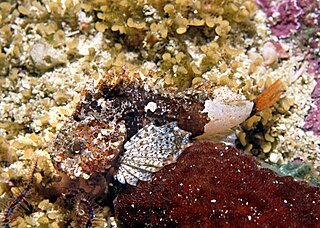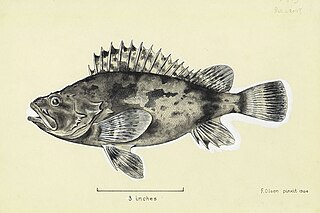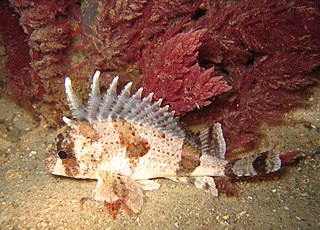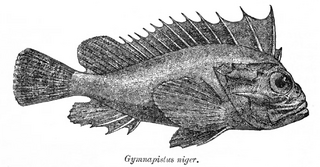
The South Australian cobbler, better known as the soldier but also known as the cobbler, devilfish or soldierfish, is a species of marine ray-finned fish, a waspfish, belonging to the subfamily Tetraroginae which is classified within the family Scorpaenidae, the scorpionfishes and their relatives. It is endemic to southern Australia. It is the only species in the monotypic genus Gymnapistes.

The smoothskin scorpionfish is a species of ray-finned fish, a waspfish belonging to the subfamily Tetraroginae of the family Scorpaenidae, the scorpionfishes and their relatives. It is the only species in the monotypic genus Coccotropsis. This species is endemic to the seas off South Africa.

The bartail flathead, also known as the Indian flathead, gobi or Indo-Pacific flathead, is a species of largely marine ray-finned fish belonging to the family Platycephalidae, the flatheads. This species is found in the Indian Ocean and the Western Pacific Ocean, and has invaded the eastern Mediterranean Sea.

The bullrout, also commonly called freshwater stonefish or kroki, is a pale yellowish to dark-brown coloured fish that lives in tidal estuaries and slow-flowing streams in eastern Australia, from Southern New South Wales to northern Queensland, Australia. It has on a very infrequent occurrence been caught at sea. Its spines are venomous. It is the only member of the genus Notesthes.

Centropogon is a genus of ray-finned fishes, waspfishes belonging to the subfamily Tetraroginae, which is classified as part of the family Scorpaenidae, the scorpionfishes and their relatives. These fishes are endemic to the brackish and marine waters around Australia.

Paracentropogon longispinis, the wispy waspfish, sailfin waspfish, whiteface waspfish or whiteface roguefish, is a species of marine ray-finned fish, a waspfish belonging to the subfamily Tetraroginae, which is classified as part of the family Scorpaenidae, the scorpionfishes and their relatives. It is found in the central Indo-West Pacific. It is the type species of the genus Paracentropogon.

The stargazing stonefish is a species of stonefish native to the Indian Ocean and the western Pacific Ocean where it is found on muddy bottoms in estuaries. This venomous species is also a minor component of local commercial fisheries. This species grows to a length of 8 centimetres (3.1 in) SL. This species is the only known member of the genus Trachicephalus.

The marbled spinefish, also known as the yellow waspfish, is a species of ray-finned fish, a waspfish belonging to the subfamily Tetraroginae of the family Scorpaenidae, the scorpionfishes and their relatives. It is the only species in the monotypic genus Cottapistus. This species is found in the Indo-West Pacific.

Glyptauchen is a monotypic genus of marine ray-finned fish belonging to the subfamily Tetraroginae, the waspfishes. The only species in the genus is the goblinfish, also known as the saddlehead or saddlehead goblinfish which is endemic to the southern coasts of Australia. The goblinfish has venomous spines in its fins.
Liocranium is a small genus of marine ray-finned fishes, waspfishes belonging to the subfamily Tetraroginae, which is classified as part of the family Scorpaenidae, the scorpionfishes and their relatives. The fishes in this genus are found in the eastern Indian Ocean and the western Pacific Ocean.
Neocentropogon is a poorly known genus of marine ray-finned fishes, waspfishes belonging to the subfamily Tetraroginae, which is classified as part of the family Scorpaenidae, the scorpionfishes and their relatives. The fishes in this genus are native to the Indian Ocean and the western Pacific Ocean.

Ocosia is a genus of ray-finned fishes, waspfishes belonging to the subfamily Tetraroginae, which is classified as part of the family Scorpaenidae, the scorpionfishes and their relatives. These fish are found in the Indian Ocean and western Pacific Ocean.

Paracentropogon is a genus of ray-finned fishes, waspfishes belonging to the subfamily Tetraroginae, which is classified as part of the family Scorpaenidae, the scorpionfishes and their relatives, These fish are found in the Indian Ocean and western Pacific Ocean.

Richardsonichthys, is a monotypic genus of marine ray-finned fish belonging to the subfamily Tetraroginae, the waspfishes, which is classified as part of the family Scorpaenidae, the scorpionfishes and their relatives. The only species in the genus is the whiteface waspfish, also known as the whitebelly roguefish, rouge fish, Torres Strait soldier fish or Richardson's waspfish. This species is native to reefs of the Indian Ocean and the western Pacific Ocean.

Snyderina is a genus of ray-finned fishes, waspfishes belonging to the subfamily Tetraroginae, which is classified as part of the family Scorpaenidae, the scorpionfishes and their relatives. These fishes are found in the western Indian Ocean and the western Pacific Ocean.

Tetraroge is a genus of ray-finned fishes, waspfishes belonging to the subfamily Tetraroginae, which is classified as part of the family Scorpaenidae, the scorpionfishes and their relatives. These fishes are native to the Indian Ocean and the western Pacific Ocean.

Minous monodactylus, the grey stingfish or grey goblinfish, is a species of marine ray-finned fishes, it is the only genus in the tribe Minoini, one of the three tribes which are classified within the subfamily Synanceiinae within the family Scorpaenidae, the scorpionfishes and their relatives. This species found in the Indo-Pacific and is venomous to humans.

Ablabys macracanthus, also known as the spiny waspfish or as the spiny leaf-fish in Indonesia, is a species of marine ray-finned fish, a waspfish belonging to the subfamily Tetraroginae of the family Scorpaenidae, the scorpionfishes and their relatives. This species is found in the Western Pacific and Indian Oceans.

The mangrove waspfish, also known as the goblinfish, is a species of marine ray-finned fish, a waspfish belonging to the subfamily Tetraroginae, which is classified as part of the family Scorpaenidae, the scorpionfishes and their relatives. This species occurs in the Indo-Pacific region.
Pterygotrigla multiocellata, the antrorse spined gurnard, is a species of ray-finned fish belonging to the family Triglidae, the gurnards and sea robins. This fish is found in the Indo-Pacific region where it has been recorded from Japan, Saipan, and the eastern and western tropical waters off Australia.

















